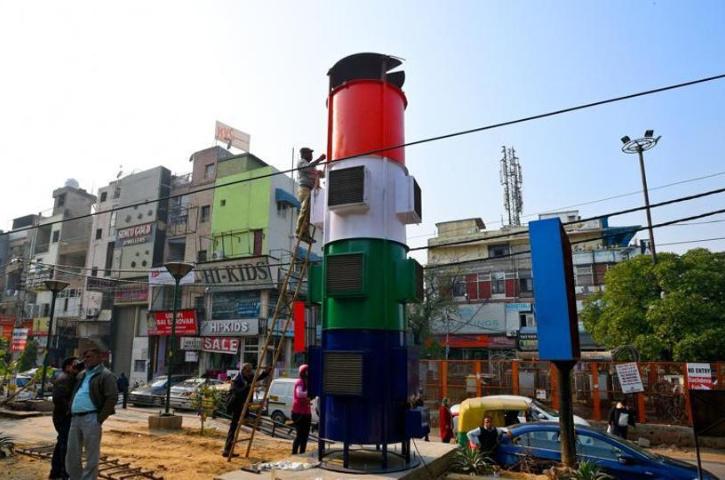
NEW DELHI: Delhi’s first smog tower became operational on January 3 at the Central market, Lajpat nagar. The tower was inaugurated by Gautam Gambhir, Member of Parliament, East Delhi.
The tower sucks in the polluted air and pumps out clean, filtered air. The operators rejoiced as once the tower became operational, the PM 2.5 reading, which was fluctuating around 165, around the smog tower area declined sharply to a mere 2 or 3 within a few minutes.
The 20-foot tower has multiple blowers which emits up to 2,40,000- 6,00,000 m3 of clean air per day. The tower is developed by Dharmendra Bhaskar, Co-Founder and Managing Director of Shuddh Electronics Pvt Ltd, a Noida based startup, supported by Startup India initiative and is funded by Gautum Gambhir Foundation. In a conversation with Urban update, Dharmendra Bhaskar said, “The machine operates on the principle of Advanced Controlled Electrostatic Precipitate, which is an advanced version of the filtration technology used in atomic reactors.”
Bhaskar told Urban Update that he was working primarily on the tower for over a year now in close coordination with the consultation of a French engineer. “Air purifiers designed using this technology are already prevalent across Europe. You can find them even in bullet trains, where compartments are fitted with them,” he said.
The machine can adequately supply clean air to a radius of 300 meters, but Bhaskar expects the clean air to reach even further. The installation is made on a land which is directly built above a sewer drain and according to him, the air purifier also removes the stench from the air along with cleaning all sorts of impurities.
Experts have questioned the effectiveness of smog towers in India as previously installed air purifiers at ITO chowk, which were modelled after the smog tower installed in Beijing, seized in 16 days. “Those air purifiers used HEPA technology, which is inadequate to tackle Delhi’s air. They can be used for indoor air purification. This technology that we employ could provide a long term solution for Delhi’s woes,” said Bhaskar.
The machine requires minimum maintenance as it is made up of washable and reusable components. The engineer estimates that a minimum of Rs 3000 per month is required for its upkeep. The machine would operate 24 hours a day, but the exhaust speed would be reduced at night as the market area is less populated at that time. The electricity requirement is about 40-55 units per day and Lajpat Nagar Traders Association would be billed with the electricity cost.
When asked about further plans, Bhaskar said, “This is the pilot project for us and is supported by East Delhi MP Gautum Gambhir. We are open to make more of such installations in the near future.” The project operation is set for a minimum of 10 years and based on its effectiveness in the area, it could probably be expanded to other parts of the city as well.
